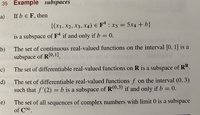Glaussesness
New member
- Joined
- Feb 2, 2021
- Messages
- 1
Hi,
My textbook gives some examples relating to subspaces but I am having trouble intuiting them.
Could someone please help me understand the five points they are attempting to convey here (see screenshot).
Again, I am aware that these are rather beginner but I would like to have an extremely solid foundation before moving forward - walking me through the finer points would be amazing.
Your patience with a fool is appreciated

My textbook gives some examples relating to subspaces but I am having trouble intuiting them.
Could someone please help me understand the five points they are attempting to convey here (see screenshot).
Again, I am aware that these are rather beginner but I would like to have an extremely solid foundation before moving forward - walking me through the finer points would be amazing.
Your patience with a fool is appreciated

